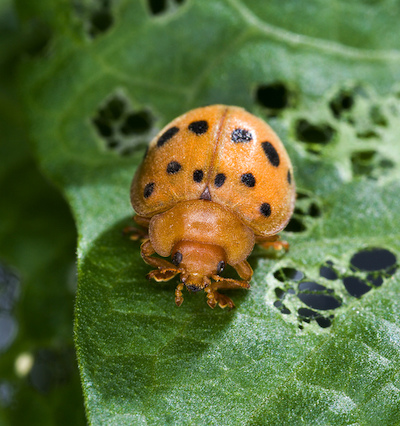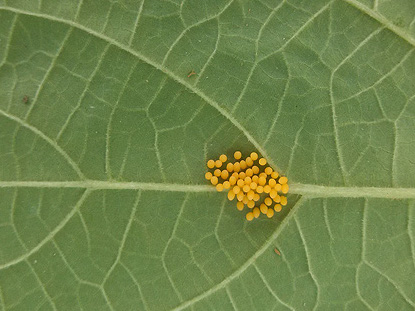Beat The Mexican Bean Beetle
By Leslie Moore, Fairfax Master Gardener Intern
 Have you have ever seen a copper- to tan-colored ladybug beetle in your garden and wondered about it? This is the Mexican bean beetle (Epilachna varivestus Mulsant), a relative to the beneficial ladybird beetle. However, this beetle is not beneficial and in fact can cause a lot of damage to your green beans, lima beans, shell beans and soybeans. It is native to Mexico but has been found in the U.S. since 1860 and has since migrated north to Canada. In Virginia, it is common in the Mid-Atlantic and southern Appalachian regions. It is also a relative to the destructive squash lady beetle, (Epilachna borealis Fabricius), which feeds mostly on cucumbers, squash, melons, gourds and pumpkins.
Have you have ever seen a copper- to tan-colored ladybug beetle in your garden and wondered about it? This is the Mexican bean beetle (Epilachna varivestus Mulsant), a relative to the beneficial ladybird beetle. However, this beetle is not beneficial and in fact can cause a lot of damage to your green beans, lima beans, shell beans and soybeans. It is native to Mexico but has been found in the U.S. since 1860 and has since migrated north to Canada. In Virginia, it is common in the Mid-Atlantic and southern Appalachian regions. It is also a relative to the destructive squash lady beetle, (Epilachna borealis Fabricius), which feeds mostly on cucumbers, squash, melons, gourds and pumpkins.
The adult Mexican bean beetle is tan- to copper-colored and slightly larger in size to the ladybug. To help distinguish it from a ladybug, remember that it has 16 black spots arranged in three rows, and does not have a black head. It can walk or fly, but once it finds its host plant is sluggish while eating or mating. Most of its life is spent on the host plant; however, it will fly to other places to overwinter.

Beetle eggs on underside of leaf
Larvae are cylindrical and yellow and covered in spines that are black or yellow with black tips. They remain attached to the bottom of the leaves and do tremendous damage while feeding. The pupae resemble the larvae but are attached to the plant and are immobile. Pupation lasts around nine days and the life cycle begins again. Several generations will occur in Virginia yearly.
The adults and larval stages will feed mostly on the underside of leaves, creating a lacy, skeletonized appearance of the leaves. They will also feed on the bean pods and flowers, if present and leaves are scarce. They prefer snap beans (Phaseolus vulgaris) and lima beans (Phaseolus lunatus) and can cause severe commercial damage to soybeans (Glycine max).

Beetle larva
Manage outbreaks by crushing egg clusters, larvae and adults by hand. Plastic reflective mulch has been found to be beneficial. Polyester or floating row covers have shown to reduce the numbers of the adult and larval beetles. There is a parasitic wasp, the eulophid wasp (Pediolbius foveolatus), that is not native to the United States. It has shown to be effective in reducing the number of beetles while being harmless to people and beneficial insects. The wasp will lay its eggs in a beetle larvae which will die. The adult wasps will emerge and lay more eggs in other beetle larvae. They will also kill squash beetles. These can be ordered online and released yearly since they do not winter over. Release them when the beetle eggs begin to hatch.
Organic Insecticides can be used with success, such as pyrethrins, spinosad and azadirachtin. Read all instructions on the label and heed all cautions concerning application.
Resources
• Mexican bean beetle — Epilachna varivestus Mulsant, University of Florida, Department of Entomology
and Nematology
• Mexican Bean Beetle, Vegetables — Home and Garden Information Center, University of Maryland
• Mexican bean beetle, Publications and Educational Resources. Virginia Cooperative Extension